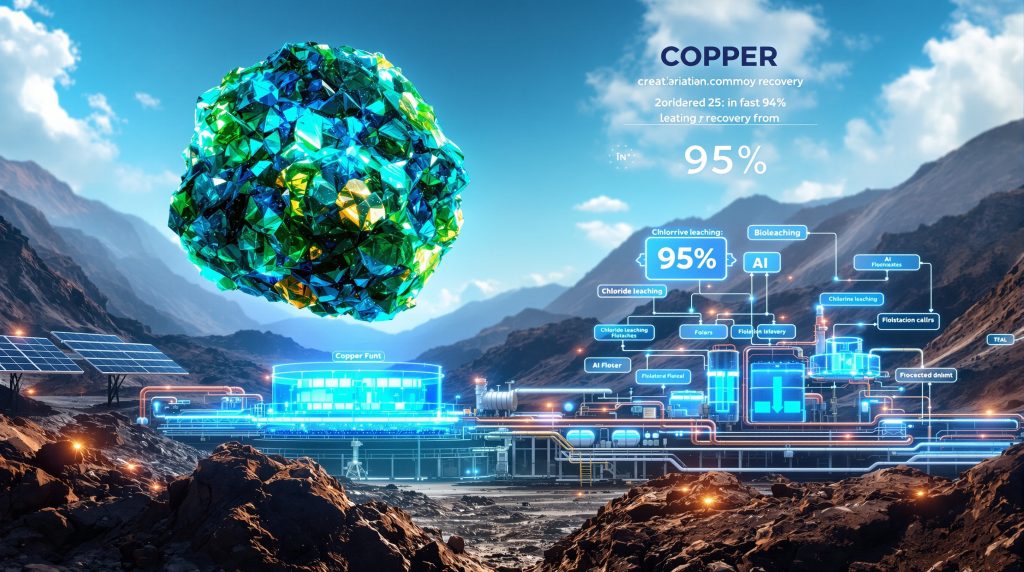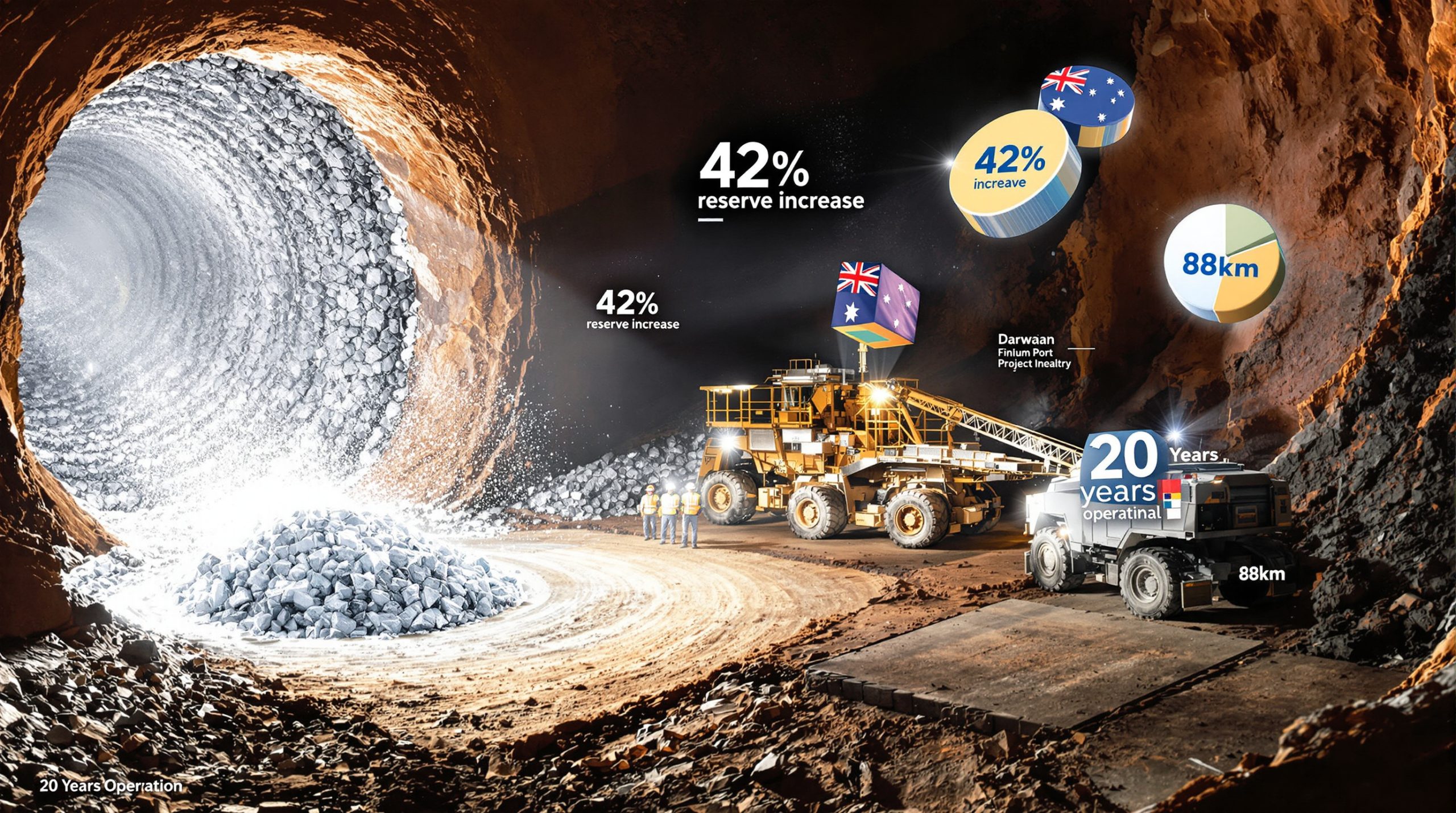Revolutionary Copper Recovery Technologies: Transforming Mining Economics and Sustainability
What Is Driving Innovation in Copper Recovery Technology?
The global push toward electrification and renewable energy is creating unprecedented demand for copper, with projections indicating consumption will double by 2040. This demand surge coincides with declining ore grades and increasing complexity of remaining deposits, creating a perfect storm that necessitates technological breakthroughs in copper recovery methods.
Electric vehicles require four times more copper than internal combustion engines, while renewable power infrastructure demands substantially more copper than traditional energy systems. With the average lead time from discovery to production now exceeding 15 years, the industry faces significant pressure to maximize recovery from existing and near-term projects.
Traditional copper processing methods typically achieve recovery rates of approximately 80%, leaving substantial value in tailings facilities. As industry leader Chris Stevens noted, "Mathematically, financially, there's an awful lot of money left in the tailings dump if you're recovering 80%." This reality has driven intense innovation across the copper processing landscape.
How Do Modern Copper Recovery Technologies Compare to Traditional Methods?
The Limitations of Conventional Recovery
Traditional copper processing methods typically achieve recovery rates of approximately 80%, leaving significant value in tailings. These conventional approaches often require:
- Complex flotation circuits
- Energy-intensive grinding to fine particle sizes
- Substantial water consumption
- Oxygen plants for certain processing routes
- High capital expenditure requirements
The economic implications of these limitations become particularly significant as ore grades decline globally. Projects processing material below 0.5% copper face challenging economics unless technological innovations can improve recovery rates and reduce processing costs.
Breakthrough Recovery Technologies
Recent innovations have transformed copper extraction efficiency:
| Technology | Recovery Rate | Traditional Comparison | Key Advantages |
|---|---|---|---|
| Advanced Chloride Leaching | Up to 95% | +15% over flotation | Eliminates flotation circuits; allows coarser grinding |
| Catalyzed Heap Leaching | 85-90% for sulfides | +30-40% for primary sulfides | Unlocks previously uneconomic ore bodies |
| Microbial Bioleaching | 85% from primary sulfides | +25-30% for chalcopyrite | Environmentally sustainable; lower energy requirements |
| Advanced Flotation Systems | 86-92% | +6-12% improvement | AI-controlled optimization; biodegradable reagents |
These technological advances directly translate to enhanced project economics, with recovery improvements of 10-15% potentially increasing net present values by hundreds of millions of dollars for medium to large-scale operations.
Recent commercial implementations validate these breakthrough copper recovery technology. Coda Minerals achieved 95% copper recovery compared to the previous 80% flotation-based process, while Abitibi Metals reported exceptional recovery rates of 98% copper, 90% gold, 96% zinc, and 70% silver at their B26 deposit.
What Makes Chloride Leaching a Game-Changer for Copper Projects?
Chloride-based leaching represents one of the most significant breakthroughs in copper processing technology, offering transformative benefits across multiple dimensions:
Technical Advantages
- Superior Recovery Rates: Achieves up to 95% copper recovery compared to 80% from conventional flotation
- Process Simplification: Eliminates complex flotation circuits and oxygen plants
- Reduced Energy Requirements: Enables coarser grinding operations, significantly lowering power consumption
- Broader Ore Applicability: Effectively processes mixed oxide-sulfide ores that challenge conventional methods
The chloride leaching approach solves a fundamental industry challenge by enabling effective processing of transitional and mixed mineral assemblages that often create recovery complications in conventional circuits.
Economic Impact
- Capital Expenditure Reduction: Recent implementations have demonstrated CAPEX reductions of $70-80 million through simplified processing requirements
- Enhanced Project Economics: NPV improvements of 30-40% at current copper prices due to higher recoveries
- Reduced Operational Complexity: Simplified flowsheets decrease operational risks and maintenance requirements
- Tailings Value Capture: Recovers significant copper value previously lost to tailings facilities
The technology has been successfully implemented at operations like Elizabeth Creek, where it transformed marginal economics into robust financial returns with post-tax NPVs exceeding $850 million at conservative pricing assumptions. Coda Minerals reduced total capital expenditure by AUD $74 million through simplified processing requirements, while delivering a post-tax net present value of A$855 million, scaling to approximately A$1.2 billion at current spot prices with a 38% internal rate of return.
Perhaps most significantly, the technology enables viable project economics without dependency on specialty metals. As industry executives have noted, projects can achieve "peer comparable" economics based solely on copper and silver production, with "much more bankable commodities with deep liquid markets."
How Are Biological Solutions Revolutionizing Copper Extraction?
Bioleaching technologies represent a sustainable frontier in copper recovery, leveraging microbial processes to extract metal from challenging ore bodies:
Microbial Innovation
Advanced bioleaching processes utilize specialized microorganisms to catalyze the oxidation of copper minerals, particularly the historically challenging chalcopyrite (primary copper sulfide). These microbes:
- Accelerate natural oxidation processes
- Operate effectively at moderate temperatures
- Create conditions that enhance copper solubility
- Maintain activity across varying ore compositions
The biological approach addresses a fundamental industry challenge: efficiently processing primary copper sulfides without requiring the high temperatures, pressures, and chemical inputs associated with conventional processing routes.
Commercial Implementation
Bioleaching technologies have progressed from laboratory curiosities to commercial-scale operations:
- Johnson Camp Operation: Achieving up to 85% recovery from primary sulfide ores
- Collaborative Development: Major miners including Rio Tinto and BHP have established partnerships with biotech firms to scale these technologies
- Production Scale: Several operations now processing millions of tonnes annually using bioleaching techniques
This approach has attracted strategic interest from major mining companies seeking sustainable processing alternatives. BHP has invested in multiple bioleaching technology partnerships, recognizing the potential to unlock value from challenging ore bodies while addressing environmental constraints.
Sustainability Benefits
Bioleaching offers compelling environmental advantages:
- 30-50% reduction in carbon emissions compared to conventional processing
- Elimination of smelting requirements for certain ore types
- Significantly reduced water consumption through closed-loop systems
- Minimal chemical inputs compared to aggressive leaching alternatives
The lower energy requirements and reduced chemical consumption make bioleaching particularly attractive in regions with strict environmental regulations or challenging operating conditions.
What Role Do Catalyzed Leaching Systems Play in Copper Recovery?
Catalyst-enhanced leaching represents a breakthrough approach for processing copper sulfides, particularly in heap leaching applications:
Catalyst Mechanisms
These systems employ proprietary catalysts that:
- Enhance acid penetration into sulfide mineral structures
- Accelerate dissolution kinetics at ambient temperatures
- Overcome passivation layers that typically inhibit leaching
- Enable effective processing of mixed mineral assemblages
The catalyst approach specifically addresses the formation of passivation layers that traditionally limit copper extraction from primary sulfide minerals during conventional leaching processes.
Performance Metrics
Commercial implementations have demonstrated remarkable results:
- Production increases of 100-200% at operating sites
- Effective copper recovery from previously sub-economic waste material
- Processing of challenging ore types without requiring fine grinding
- Significant reduction in leach cycle times
These performance improvements have been validated through multiple commercial implementations, with operations reporting sustained production enhancements over extended periods.
Economic Transformation
The technology has revitalized projects that were previously considered marginal:
- Pinto Valley operation doubled copper production through catalyst implementation
- Several operations have extended mine life by 10+ years by making low-grade material economic
- Capital efficiency improvements of 30-40% compared to conventional processing routes
The ability to process previously sub-economic material creates opportunities to extract additional value from existing operations while extending mine life and improving overall resource utilization.
How Do Advanced Flotation Technologies Enhance Copper Recovery?
While leaching innovations have captured significant attention, advanced flotation technologies continue to evolve with impressive results:
Next-Generation Flotation Systems
Modern flotation circuits incorporate:
- AI-Driven Process Control: Real-time optimization of reagent addition and bubble dynamics
- Biodegradable Reagents: Enhanced selectivity with reduced environmental impact
- Energy-Efficient Grinding: Advanced classification systems that prevent over-grinding
- Integrated Circuit Design: Optimized flowsheets that maximize recovery across particle size ranges
These innovations build upon conventional flotation approaches while addressing traditional efficiency limitations through sophisticated process control and optimized reagent chemistry.
Performance Improvements
These innovations deliver measurable benefits:
- Recovery improvements of 6-12% compared to conventional flotation
- Grade improvements of 1-3% copper in final concentrates
- Energy consumption reductions of 15-25%
- CO₂ emission reductions of 10-45% depending on implementation
While the percentage improvements may appear modest compared to breakthrough leaching technologies, the ability to retrofit existing operations without complete flowsheet redesigns offers compelling advantages for established operations.
Implementation Status
Advanced flotation technologies have seen rapid commercial adoption:
- Multiple major operations implemented AI-controlled systems since 2023
- Biodegradable reagent suites now standard at approximately 30% of new developments
- Hybrid flotation-hydrometallurgical circuits gaining traction for complex ores
The integration of digital technologies with advanced process control has accelerated implementation timelines, with operations reporting payback periods of less than 12 months for certain optimization initiatives.
What Economic Impact Do These Technologies Have on Copper Projects?
The financial implications of advanced recovery technologies extend far beyond incremental improvements, fundamentally transforming project economics:
Capital Efficiency Enhancements
Projects implementing breakthrough technologies demonstrate exceptional capital efficiency metrics:
- Production capacity costs below $12,000 per tonne of annual copper production
- CAPEX reductions of 15-30% compared to conventional processing routes
- Accelerated construction timelines through simplified processing facilities
- Reduced infrastructure requirements (power, water, reagent handling)
Marimaca Copper exemplifies this capital efficiency advantage, positioning in the bottom decile globally with production capacity costs under $12,000 per tonne of copper equivalent production. As their CEO highlighted: "What I'm pleased about is it confirms that we are in the bottom decile of capital intensity for new development stage copper projects globally."
Operating Cost Benefits
Operational expenditures see significant improvements:
- Processing cost reductions of $0.20-0.40 per pound of copper produced
- Energy consumption decreases of 20-30% across the processing chain
- Reagent consumption reductions of 15-25%
- Maintenance cost decreases through simplified equipment requirements
The power consumption advantages become particularly significant in regions with high electricity costs. Marimaca benefits from low-cost power at 9 cents/kWh all-in in Northern Chile, but operations in higher-cost jurisdictions can achieve even greater operating cost advantages through energy efficiency improvements.
Project Valuation Impact
These improvements translate directly to enhanced valuations:
- Internal rates of return exceeding 30% at current copper prices
- NPV improvements of 30-50% compared to conventional processing approaches
- Enhanced project resilience at lower copper price scenarios
- Significantly improved payback periods (often below 3 years)
Marimaca delivers over $700 million in post-tax NPV with IRR exceeding 30% at a base case copper price insights of $4.30 per pound. At higher copper price assumptions, the NPV scales to over $1 billion with IRR reaching the mid-40% range. Similarly, Coda Minerals projects a post-tax NPV of A$855 million at conservative pricing assumptions, scaling to approximately A$1.2 billion at current spot prices with a 38% internal rate of return.
How Do These Technologies Address Environmental and Sustainability Challenges?
Beyond economic benefits, advanced recovery technologies deliver critical sustainability improvements:
Environmental Footprint Reduction
Key environmental metrics show substantial improvement:
- Water consumption reductions of 30-50% through closed-loop systems
- Energy requirements decreased by 15-40% depending on technology
- Greenhouse gas emissions reduced by 10-45%
- Chemical consumption minimized through more efficient processes
These environmental advantages become increasingly important as mining companies face stricter sustainability requirements from both regulatory bodies and investors. The ability to demonstrate reduced environmental impacts represents a competitive advantage in permitting processes and capital raising activities.
Waste Management Advantages
Tailings and waste management see significant benefits:
- Higher recovery rates mean less metal reporting to tailings facilities
- Reduced tailings volumes through more efficient processing
- Lower contaminant mobility in processed materials
- Potential for tailings reprocessing to recover additional value
The waste management benefits extend beyond environmental considerations to practical operational advantages. Reduced tailings volumes decrease storage requirements and associated infrastructure costs, while improved metals recovery from waste streams creates additional revenue opportunities.
Regulatory Alignment
These technologies align with increasingly stringent regulatory requirements:
- Reduced permitting complexity through improved environmental profiles
- Enhanced social license through demonstrated sustainability commitment
- Alignment with carbon reduction mandates in key mining jurisdictions
- Competitive advantage in jurisdictions with carbon pricing mechanisms
As carbon pricing mechanisms expand globally, the emissions reductions achieved through advanced processing technologies translate directly to operating cost advantages in addition to regulatory compliance benefits.
What Does the Future Hold for Copper Recovery Innovation?
The innovation pipeline for copper recovery technologies remains robust, with several emerging approaches showing promise:
Near-Term Developments
Technologies approaching commercial implementation include:
- Electrochemical Leaching: Direct electron transfer systems that eliminate traditional leaching reagents
- Advanced Sensor Technologies: Real-time mineralogical analysis enabling dynamic process adjustments
- Hybrid Processing Routes: Integrated systems combining multiple recovery technologies for optimal performance
- Ambient Pressure Oxidation: Low-temperature oxidative processes for sulfide minerals
These near-term innovations build upon established technology platforms while addressing specific processing challenges or efficiency opportunities.
Longer-Term Research Directions
Fundamental research continues in several promising areas:
- Synthetic Biology: Engineered microorganisms with enhanced leaching capabilities
- Targeted Mineral Liberation: Selective fragmentation technologies that reduce energy requirements
- Direct Extraction Systems: Technologies that bypass conventional concentration steps
- Zero-Waste Processing: Closed-loop systems that eliminate waste streams entirely
While these longer-term developments carry higher technical risk, they also offer potential paradigm shifts in processing approaches that could further transform industry economics.
Implementation Timeline
The commercialization pathway suggests:
- 2025-2027: Widespread adoption of current breakthrough technologies
- 2027-2030: Commercial implementation of near-term developments
- 2030-2035: Potential paradigm shifts through fundamental technology breakthroughs
The accelerated pace of innovation reflects both the economic imperative of improving copper recovery and the broader industry focus on sustainable resource development.
How Are Strategic Partnerships Accelerating Technology Adoption?
The development and implementation of breakthrough copper recovery technology increasingly rely on strategic partnerships between various stakeholders:
Mining-Technology Collaborations
Major copper producers have established formal partnerships with technology providers:
- BHP's collaboration with biotech firms for microbial leaching solutions
- Rio Tinto's Nuton technology platform combining multiple innovation streams
- Glencore's partnership with chemical extraction specialists for in-situ applications
These strategic partnerships combine financial resources with technical expertise and operational testing capabilities, accelerating the path from laboratory development to commercial implementation.
Research Institution Engagement
Academic and research organizations play crucial roles:
- University research centers developing fundamental process understanding
- Government laboratories providing testing and validation services
- Industry consortia pooling resources for pre-competitive research
Government support for innovation often extends beyond research funding to strategic co-development arrangements. Abitibi Metals operates through a partnership with SOQUEM, a subsidiary of Investment Quebec, leading to $25 million of government investment into asset development.
Implementation Case Studies
Successful technology transfers demonstrate the value of collaborative approaches:
- Elizabeth Creek project's implementation of chloride leaching technology
- Pinto Valley's catalyst-enhanced heap leaching system
- Johnson Camp's bioleaching commercial demonstration
These case studies provide important validation of technology performance under commercial operating conditions, reducing perceived implementation risks for subsequent adopters.
How Do Jurisdictional Factors Influence Technology Implementation?
The adoption of advanced recovery technologies varies significantly by jurisdiction, influenced by multiple factors:
Infrastructure Advantages
Established mining regions offer implementation advantages:
- Chile: Access to renewable energy and established processing expertise
- Australia: Advanced regulatory frameworks supporting innovation
- Canada: Strong technical capabilities and research infrastructure
- United States: Growing focus on domestic critical mineral supply chains
Quebec emerges as a particularly attractive jurisdiction, with projects benefiting from existing infrastructure that reduces capital requirements. As one executive noted regarding their Quebec project: "We have a power line that runs through the project, a substation. So, a lot of that expensive infrastructure is in place that we can leverage."
Similarly, Metal Energy's Highland Valley copper project benefits from a power line traversing the property with an existing substation, providing year-round road access that enables continuous drilling operations.
Regulatory Considerations
Regulatory environments significantly impact technology adoption:
- Permitting timelines for novel processing approaches
- Environmental performance requirements
- Water use restrictions in arid regions
- Carbon pricing mechanisms influencing technology selection
Companies increasingly factor these regulatory considerations into technology selection decisions, recognizing that regulatory advantages can translate directly to competitive positioning.
Strategic Positioning
Projects strategically positioned in favorable jurisdictions benefit from:
- Access to skilled technical workforces
- Established supply chains for specialized equipment and reagents
- Government support for innovation and sustainability initiatives
- Proximity to end-users in electrification supply chains
These strategic advantages extend beyond project economics to development timelines, with established jurisdictions often offering accelerated permitting processes for projects demonstrating enhanced environmental performance.
What Are the Investment Implications of Copper Recovery Breakthroughs?
For investors, advanced copper recovery technologies create multiple value opportunities:
Project Evaluation Criteria
When assessing copper projects, technology implementation becomes a critical differentiator:
- Recovery rates significantly impact project economics
- Capital efficiency metrics reflect technology advantages
- Operating cost profiles demonstrate competitive positioning
- Sustainability performance influences long-term viability
The implementation of breakthrough technologies can transform marginal projects into compelling copper investment strategies, as demonstrated by multiple case studies where technological innovation dramatically enhanced net present values and internal rates of return.
M&A Activity Indicators
Recent transaction activity highlights the premium placed on technological advantage:
- Acquisitions targeting projects with demonstrated recovery improvements
- Valuation premiums of 30-50% for projects implementing breakthrough technologies
- Strategic partnerships focused on technology access and implementation
- Growing focus on securing processing expertise alongside resource potential
Harmony Gold's acquisition of MAC Copper for over $1 billion represents a 50,000-tonne project similar in scale to several development-stage companies, while competitive bidding between Kinross and Cameco for New World Resources demonstrates strong buyer interest.
Industry executives note the strategic rationale driving these premium valuations: "There are very few actionable copper projects in the near term that can become a reasonably significant producer of copper," highlighting the scarcity value of near-term production assets.
Investment Thesis Components
A comprehensive copper investment thesis should consider:
- Structural supply deficit driven by electrification demand
- Technical innovation advantages creating competitive differentiation
- Quality project pipeline with demonstrated recovery improvements
- M&A premium environment for technologically advanced projects
- Jurisdiction risk mitigation through established mining regions
The combination of breakthrough recovery technologies and favorable market fundamentals creates compelling investment opportunities across the copper development spectrum.
Conclusion: The Transformative Impact of Copper Recovery Innovation
Breakthrough copper recovery technologies represent a fundamental shift in the industry's approach to resource development. By dramatically improving recovery rates, reducing environmental impacts, and enhancing project economics, these innovations address the dual challenges of meeting growing copper demand while improving sustainability performance.
For projects implementing these technologies, the benefits extend beyond incremental improvements to transformative economic impacts. Recovery rates exceeding 95%, capital efficiency metrics below $12,000 per tonne of annual production capacity, and internal rates of return above 30% demonstrate the compelling case for technological innovation.
As the global economy accelerates toward electrification and renewable energy, secure global copper supply forecast becomes increasingly critical. Projects combining technological excellence with strategic positioning in stable mining jurisdictions will play essential roles in meeting this demand while delivering exceptional returns for investors who recognize the transformative potential of these breakthrough copper recovery technology.
The future of copper mining will increasingly be defined by mining innovation trends and advancements in gold & copper exploration that maximize resource recovery and minimize environmental impact, creating a more sustainable foundation for the clean energy transition.
Further Exploration:
Readers interested in learning more about innovations in copper processing can explore related educational content from industry publications such as Mining Engineering Magazine and the Society for Mining, Metallurgy & Exploration's technical resources, which offer additional perspectives on emerging technologies in the mining sector.
Want to Know About the Next Major ASX Mineral Discovery Before the Market?
Discovery Alert's proprietary Discovery IQ model delivers real-time notifications when significant mineral discoveries are announced on the ASX, giving investors a crucial edge in both short and long-term investment decisions. Visit the Discovery Alert discoveries page to understand how historic discoveries have generated exceptional returns and begin your 30-day free trial today.




